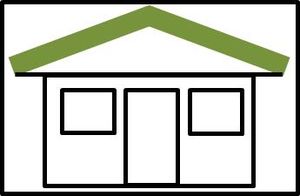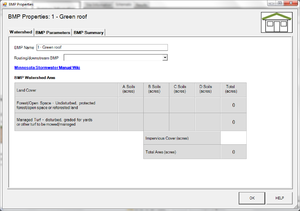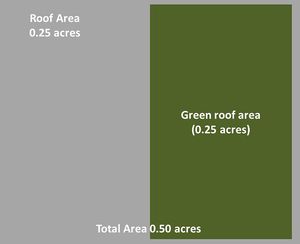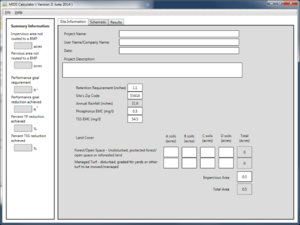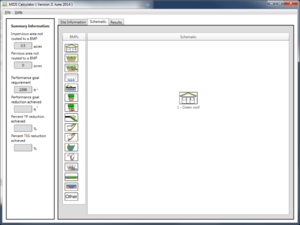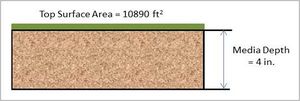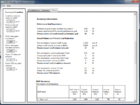
Requirements, recommendations and information for using green roofs as a BMP in the MIDS calculator
For a green roof system, stormwater that is captured and stored within the soil is removed from the system through evapotranspiration. The green roof does not provide phosphorus (P) reduction and reduces outflow total suspended solid (TSS) concentrations to 2.25 milligrams per liter.
Contents
Version 4 updates
Version 4 of the Calculator now allows the user to include an intensive green roof. This is done by allowing the user to select a media depth greater than 4 inches. A warning displays when the user selects a depth greater than 4 inches. The warning alerts the user they have designed an intensive green roof.
MIDS calculator user inputs for green roof
For green roof systems, the user must input the following parameters to calculate the volume and pollutant load reductions associated with the BMP.
- Watershed tab
- BMP Name: this cell is auto-filled but can be changed by the user.
- Routing/downstream BMP: if this BMP is part of a treatment train and water is being routed from this BMP to another BMP, the user selects the name of the BMP from the dropdown box to which water is being routed. All water must be routed to a single downstream BMP. Note that the User must include the BMP receiving the routed water in the Schematic or the BMP will not appear in the dropdown box.
- BMP watershed areas: Impervious area is the only land use that can contribute to the watershed of a green roof. The area of the green roof itself must be included in the impervious watershed area. A traditional roof can be included in the impervious area if water from the traditional roof is routed to the green roof. The area of the traditional roof cannot exceed the area of the green roof. Units are in acres.
- BMP Parameters tab
- Media surface area (AM): The surface area of the green roof. The user inputs this value in square feet. The calculator will display the surface area in acres for comparison with the watershed areas entered.
- Media depth (DM): The depth of the media, equal to the distance from the bottom of the media (i.e., top of underlying drainage layer) to the top of the media. The user inputs this value in inches.
- Media holding capacity: Moisture content at the maximum media density. This value is in cubic feet per cubic feet and is often expressed as percent volume. The value represents the amount of water that the soils are able to hold onto instead of percolating into the drainage layer. This value is restricted to 0.33 cubic feet per cubic feet (33 percent).
- BMP Summary Tab: The BMP Summary tab summarizes the volume and pollutant reductions provided by the specific BMP. It details the performance goal volume reductions and annual average volume, dissolved P, particulate P, and TSS load reductions. Included in the summary are the total volume and pollutant loads received by the BMP from its direct watershed, from upstream BMPs and a combined value of the two. Also included in the summary, are the volume and pollutant load reductions provided by the BMP, in addition to the volume and pollutant loads that exit the BMP through the outflow. This outflow load and volume is what is routed to the downstream BMP if one is defined in the Watershed tab. Finally, percent reductions are provided for the percent of the performance goal achieved, percent annual runoff volume retained, total percent annual particulate phosphorus reduction, total percent annual dissolved phosphorus reduction, total percent annual TP reduction, and total percent annual TSS reduction.
Model input requirements and recommendations
The following are requirements or recommendations for inputs into the MIDS calculator. If the following are not met, an error message will inform the user to change the input to meet the requirement.
- Green roof area cannot be greater than the total impervious area routed to the green roof
- The contributing impervious area cannot be more than 2 times the surface area of the green roof. Since the green roof itself is treated as an impervious surface in the calculator, the maximum run-on area to a green roof from a traditional roof must be equal to or less than the area of the green roof. For example, a 10,000 square foot green roof can also have 10,000 square feet or less run-on area from a traditional roof. In this example, the maximum impervious area input to the calculator is 20,000 square feet.
If the user specifies a media depth greater than 4 inches, a warning is displayed indicating the User has specified an intensive green roof.
Methodology
Required Treatment Volume
Required treatment volume, or the volume of stormwater runoff delivered to the BMP, equals the performance goal (1.1 inches or user-specified performance goal) times the impervious area draining to the BMP. This stormwater is delivered to the BMP instantaneously.
Volume Reduction
The volume reduction achieved by a BMP compares the capacity of the BMP to the required treatment volume. The Volume reduction capacity of BMP (or volume reduction credit) is calculated using BMP inputs provided by the user. For this BMP, the “Volume reduction capacity” is equal to the amount of stormwater that can be instantaneously captured by the BMP in the soils of the green roof. The capture volume (V) is given by
\(V = A_M * D_M * 0.33\)
Where:
- AM is the media surface area; and
- DM is the media depth; and
- 0.33 is the media holding capacity.
The Volume of retention provided by BMP is the amount of volume credit the BMP provides toward the performance goal. This value is equal to the lesser of the Volume reduction capacity of BMP calculated using the above method or the Required treatment volume. This check makes sure that the BMP is not getting more credit than necessary to meet the performance goal. For example, if the BMP is oversized the user will only receive credit for the Required treatment volume routed to the BMP, which corresponds with meeting the performance goal for the site.
Pollutant Reduction
Pollutant load reductions are calculated on an annual basis. For this BMP, the annual total phosphorus load reduction is restricted to 0 percent. This means that the total load of phosphorus (both particulate and dissolved) calculated to enter the green roof will exit the green roof without being removed. The total suspended solids (TSS) removal is based on the outflow event mean concentration (EMC). The outflow concentration of TSS from the green roof is set at 2.25 milligrams per liter. The remaining TSS load is filtered in the green roof and removed from the system. This results in an outflow load from the green roof equal to the outflow water volume times a concentration of 2.25 milligrams per liter. For more information see the water quality treatment section in the green roofs overview and the literature review of pollutant removal by green roofs.
NOTE: The user can modify event mean concentrations (EMCs) on the Site Information tab in the calculator. Default concentrations are 54.5 milligrams per liter for total suspended solids (TSS) and 0.3 milligrams per liter for total phosphorus (particulate plus dissolved). The calculator will notify the user if the default is changed. Changing the default EMC will result in changes to the total pounds of pollutant reduced.
Routing
A green roof can be routed to any BMP except for a swale side slope. Only another green roof BMP can be routed to a green roof BMP unless it results in water being rerouted back to the original green roof.
Assumptions
The following general assumptions apply in calculating the credit for a green roof. If these assumptions are not followed the volume and pollutant reduction credits cannot be applied.
- The green roof is properly designed
- The green roof was properly constructed, consistent with the design criteria
- The green roof is properly maintained. The performance of the green roof should be regularly assessed
Example application in the MIDS calculator
This example was completed using Version2 of the Calculator.
A green roof is going to be constructed on an existing 0.5 (21,780 square feet) acre roof. The green roof will cover half (10,890 square feet) of the existing roof and contain media with a depth of 4 inches above the drainage system. Runoff from the entire roof will drain through the green roof. The following steps detail how this system would be set up in the MIDS calculator.
Step 1: Determine the watershed characteristics of your entire site. For this example we have a 0.5 acre site with all 0.5 acres being impervious (this is because the green roof portion is included in the impervious surface area).
Step 2: Fill in the site specific information into the Site Information tab. This includes entering a Zip Code (55414 for this example) and the watershed information from Step 1. Zip code and impervious area must be filled in. Other fields on this screen are optional.
Step 3: Go to the Schematic tab and drag and drop the “Green Roof” icon into the Schematic Window.
Step 4: Open the BMP properties for the green roof by right clicking on the green roof icon and selecting Edit BMP properties, or by double clicking on the green roof icon.
Step 5: If help is needed, click on the Minnesota Stormwater Manual Wiki link or the Help button to review input parameter specifications and calculation specific to the Green roof BMP.
Step 6: Determine the watershed characteristic for the green roof. For this example the entire site is draining to the green roof therefore the watershed parameters include a 0.5 acre site with all 0.5 acres of impervious area. There is no routing for this BMP. Fill in the BMP specific watershed information, which is 0.5 acres of impervious cover.
Step 7: Click on the BMP Parameters tab and enter in the BMP design parameters. Green roof requires two entries.
- The media depth, which is 4 inches in this example
- The surface area of the green roof, which is 0.25 acres or 10890 square feet. Note this is the area of the green roof, not the entire roof area draining to the green roof.
Step 8: Click on BMP Summary tab to view results for this BMP.
Step 9: Click on the OK button to exit the BMP properties screen.
Step 10: Click on Results tab to see overall results for the site.
- MIDS calculator screen shots for green roofs. Click on an image for enlarged view.
Information
- Information on green roof design
- Guidance on characteristics of different types of green roofs
- Information on green roof construction
Links to MIDS pages
- Overview of Minimal Impact Design Standards (MIDS)
- Performance goals for new development, re-development and linear projects
- Design Sequence Flowchart-Flexible treatment options
- Community Assistance Package
- MIDS calculator
- Performance curves for MIDS calculator
- Training and workshop materials and modules
- Technical documents
Related pages
- Green roofs
- Overview for green roofs
- Types of green roofs
- Design criteria for green roofs
- Construction specifications for green roofs
- Assessing the performance of green roofs
- Operation and maintenance of green roofs
- Cost-benefit considerations for green roofs
- Plant lists for green roofs
- Case studies for green roofs
- Links for green roofs
- References for green roofs
- Supporting material for green roofs
- Green roofs terminology and glossary
- Green roof fact sheet
- Requirements, recommendations and information for using green roofs as a BMP in the MIDS calculator
This page was last edited on 11 December 2022, at 14:49.
